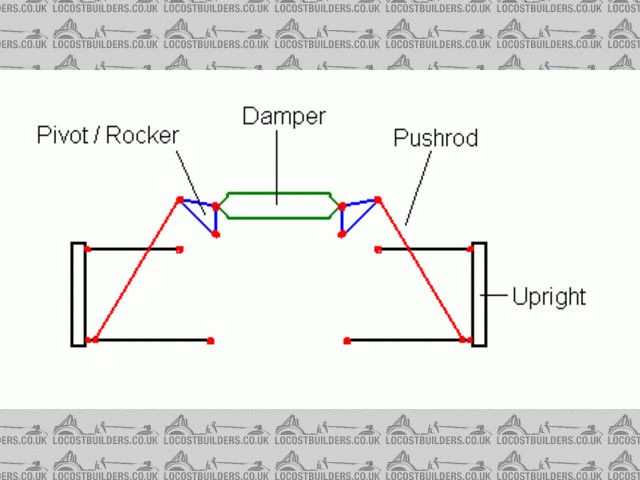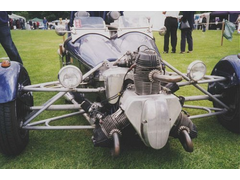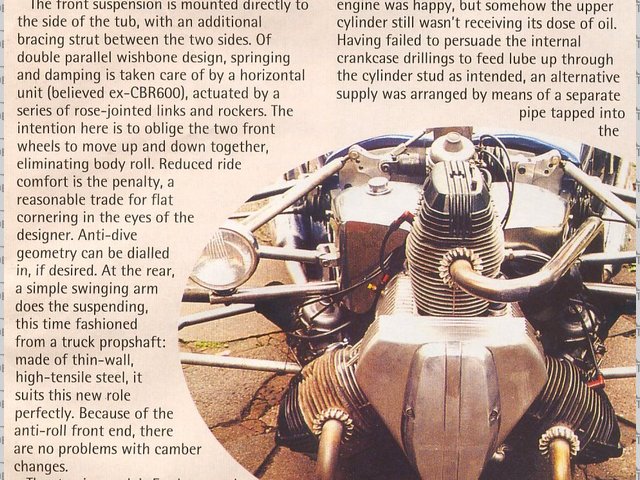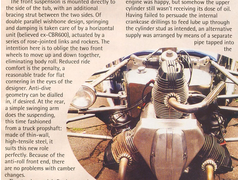
monoshock - why, whats the advantage?
MikeR - 18/2/05 at 12:39 PM
Guys,
Just seen some pics of a mono shock from the GTS challenger....
I'm curious, why use a mono shock? Whats the advantage? whats the effects with regard to handling? How does it affect the shock? Why has no one
else done it on a IRS seven? Why not use it in the front instead of twin shocks?
chrisf - 18/2/05 at 01:35 PM
It seems to me that the mono shock has built in anti roll. Another advantage is that it can easily be designed as rising rate. It also has weight
advantages.
I too am interested in how it drives--specifically how it behaves in roll and extreme bumps.
--Chris
JonBowden - 18/2/05 at 03:05 PM
Can anyone give a more detailed explanation. I just don't get this monoshock idea.
If my (poor) diagram is about right, then the spring / damper unit should resist bump that affects both wheels at the same time (eg speed bump or
squat due to acceleration).
It should provide absolutely no roll resistance at all.
I think that this should give good grip at the rear and possible understeer as the front is providing all the roll resistance.
[Edited on 18/2/05 by JonBowden]


Rescued attachment Monoshock.gif
Alan B - 18/2/05 at 03:17 PM
Jon, I asked this question myself on another thread.
Where does the roll resistance come from as none is apparent from pictures?
Edit:
This thread....
http://www.locostbuilders.co.uk/viewthread.php?tid=19793
[Edited on 18/2/05 by Alan B]
NS Dev - 18/2/05 at 03:35 PM
there are a large number of ways of doing a monoshock, some useful and have point, others less so with little point other than the "because I
could" value!
A Trishock arrangement with two normal pushrod operated shocks plus a third for antiroll is a more interesting arrangement, as it gives very tuneable
roll characteristics, but adds weight.
The system that I can not fathom out is the Dax antiroll system, which seems to be completely solid in roll but also when 1 wheel moves separate to
the other (over a bump and not in roll!)
JonBowden - 18/2/05 at 03:36 PM
Alan,
I read your previous post. Even without an anti-roll bar, normal suspension resists roll. This design does not do that. As far as I can see, if this
setup was used at both ends, the car could be pushed over with one finger. Or am I missing something - some F1 cars use a single spring / damper
Alan B - 18/2/05 at 03:43 PM
Jon, exactly my point....this set-up with the single spring not anchored to the chassis anywhere can move freely in a roll situation....it needs an
anti roll bar or some means of resisting roll.....
I understand the dual roles of bump and roll resistance in a conventional set-up and that an anti-roll bar is not always required.
NS Dev...
Yep, I've seen the arrangements you describe....all provide some roll resistance.
The question here is what provides roll resistance in THIS set-up rather than how it is usually done.
[Edited on 18/2/05 by Alan B]
[Edited on 18/2/05 by Alan B]
Piledhigher - 18/2/05 at 05:06 PM
Based on the diagram above, it looks like the shock is tied to the frame through the pivots. When there is body roll would not the shock/spring combo
resist roll based on the spring characteristics?
Cory
NS Dev - 18/2/05 at 05:39 PM
quote:
Originally posted by Alan B
Jon, exactly my point....this set-up with the single spring not anchored to the chassis anywhere can move freely in a roll situation....it needs an
anti roll bar or some means of resisting roll.....
I understand the dual roles of bump and roll resistance in a conventional set-up and that an anti-roll bar is not always required.
NS Dev...
Yep, I've seen the arrangements you describe....all provide some roll resistance.
The question here is what provides roll resistance in THIS set-up rather than how it is usually done.
[Edited on 18/2/05 by Alan B]
[Edited on 18/2/05 by Alan B]
yes, see what you mean...........nothing as far as I can see!
chunkielad - 18/2/05 at 05:40 PM
Alternative setup used in Formula Renault

[Edited on 18/2/05 by chunkielad]
JonBowden - 18/2/05 at 05:46 PM
found this diagram and description for a swing-axle suspension with a similar transverse mono-shock in formula Vee
http://www.fvee.org.au/handbook/rearsusp.html
They say there is no roll resistance
NS Dev - 18/2/05 at 05:47 PM
....................and best left on a formula renault I think!
not much use if it goes over a bump!
MikeR - 18/2/05 at 05:59 PM
damn, i was looking for a more positive view as it would fit nicely over my brand new (well new to me) audi transaxle....
looks like two shocks next to each other pivoting against the chassis would be better.
gazza285 - 18/2/05 at 06:03 PM
Works on a single seater as the roll resistance comes from the rear and race tracks are generally smooth.
chrisf - 18/2/05 at 06:12 PM
Gents:
Understand that I offered my understanding of the system. By no means was I trying to proclaim and absolute truth. As it turns out, I am wrong.
I'm still interested in how it drives.
--Many apologies for the propaganda, Chris 
MikeR - 18/2/05 at 06:15 PM
Chris all propaganda is welcome, as long as the truth is found in the end!  )
)
(disclaimer - I am not responsible for any blood letting in the finding of the truth!)
CD-5 - 18/2/05 at 06:35 PM
This look more logical for a mono shock setup. taken from the drysdale motorcycle site.
[img]http://home.mira.net/~iwd/openwheeler/dh-7.htm[/img]
NS Dev - 18/2/05 at 08:04 PM
quote:
Originally posted by MikeR
damn, i was looking for a more positive view as it would fit nicely over my brand new (well new to me) audi transaxle....
looks like two shocks next to each other pivoting against the chassis would be better.
oh dear Mike!! Hadn't you better finish this one first!!!???

MikeR - 18/2/05 at 08:29 PM
 off this week to push that along!
off this week to push that along!
NS Dev - 18/2/05 at 08:55 PM
you don't want to push it, you need an engine!!!




niceperson709 - 18/2/05 at 09:42 PM
I saw a set up like this on a 2F 1R trike he claimed it does work .
photo below , a wild machine by the way
best wishes
Iain


Rescued attachment rides03081804.jpg
niceperson709 - 18/2/05 at 09:44 PM
and here is a discription of how it works from "Motorcycle sport" magazine
best wishes
Iain
niceperson709 - 18/2/05 at 09:47 PM
help if I include the pic


Rescued attachment Radial susp003.jpg
niceperson709 - 18/2/05 at 09:49 PM
help if I include the pic


Rescued attachment Radial susp003.jpg
clbarclay - 18/2/05 at 10:43 PM
Going back to the qestion of what the advantage is, its obvious you half the cost of coil overs which start at aroud £300 for a set of 4
A set of 2 would only be £150

That Formula Renault, the suspension looks rock solid in effect it would be like using a solid (not spring steel) roll bar. precisly the oposite of
what we are all worried about.
MikeR - 18/2/05 at 10:47 PM
I was curious if it had otheer effects i couldn't obviously see. A bit like the old hydroelestic suspension, one wheel hits bump, pushing other
wheel down to smooth the ride. From the comments now i'm guessing now 
Shame really as I spent my afternoons team review figuring out how to fit a mono shock to the front and rear of the next car....... looks like i
wasted some pencil graphite.
TheGecko - 19/2/05 at 01:10 AM
The transverse mono-shock is nothing new. Len Terry describes his use of the layout on the Terrier Mk6 (1962) in "Racing Car Design and
Development". There, he correctly states the actual advantage - the layout separates the bump and roll springing. Bump springing and damping is
provided solely by the mono-shock. Roll springing is provided solely by the anti-roll bar. They can be adjusted completely independently of each
other, unlike a conventional arrangement.
Any claims that a transverse mono-shock is "inherently anti-roll" are bunkum. Simple visual analysis will quickly show that the system has
zero roll stiffness as many have stated above. The system shown on the little Drysdale racer has a very obvious anti-roll bar connected directly to
the suspension rockers.
The system shown in Chunkielad's Formula Renault is a completely different kettle of fish. That is the layout used in many (most?) formula cars
currently, with the suspension push-rods connected to a T-piece that pivots to actuate the spring/damper. Visual analysis shows that the T must pivot
up and down with simple bump and rebound (hence acting on the spring) but would try to move sideways on roll. The anti-roll springing is arranged
along the pivot-axis of the T, inside the alloy casing visible in the photo. The adjustments for roll stiffness can even be seen on the ends of the
casing. This layout even allows different roll-stiffness for left and right roll (if that takes your fancy  ).
).
Hope this helps,
Dominic
[Edited on 19/2/2005 by TheGecko]
britishtrident - 19/2/05 at 08:01 AM
A lot of designers have played with seperating roll and bump in suspension. In the kit car world Fairthrope ad more recently Dax have successfully
built cars in which the camber change in bump and roll modes were seperated.
http://www.carfolio.com/classifieds/show/?id=1
MikeR - 19/2/05 at 09:25 AM
forgive my ignorance but....... if you add an anti roll bar have you really separated bump and roll?
One wheel goes over a pot hole, it drops, twisting the anti roll bar which is linked to the other wheel - hence they are not separated. Or am i
completely missing the point?
TheGecko - 19/2/05 at 12:00 PM
Yes, single wheel bump is equivalent to roll, so seperation of bump and roll is only in the formal sense when talking about two wheel bump. However,
there aren't a lot of potholes on F1 circuits  so the single wheel bump issue isn't as big a deal. Whether monoshock makes sense for a
road car is another question......
so the single wheel bump issue isn't as big a deal. Whether monoshock makes sense for a
road car is another question......
Dominic
MikeR - 19/2/05 at 12:12 PM
ok, i'll bite.............
so what do people think about using a mono shock on a road car?
(which would be my intended application)
NS Dev - 19/2/05 at 12:49 PM
very little point, main advantage being weight loss, which won't have much effect on a road car
britishtrident - 19/2/05 at 01:19 PM
One big disadavantage I can see is zero damping in the roll mode --- normally because it shares its damping with the road spring the roll mode is way
over dammped but zero damping could lead to a rocking oscillation.
britishtrident - 19/2/05 at 01:25 PM
Looking at the trike pictures I am really puzzled it appears to have a Watt's linkage which keeps the horizonal coil spring damper unit
centralised - this would give 100% roll stiffness which might make some kind sense on a trike as for obvious reasons all the roll stiffness is at
one end of the vehicle.
Matthew_1 - 20/2/05 at 12:27 AM
Slightly off topic, but looking back at the trike pics, the front lights appear to be attached to the wishbones - is that legal ? I assume he's
got lights to drive on the roads so it must have passed SVA ?
Mind you, where's the front number plate go ?
clbarclay - 20/2/05 at 01:14 AM
Talking of the trike, look closely at the left hand side of the coil over. the looks to be a linkage going diaganally up and right from behind where
the coil over is bolted on.
Does any one no if this is part of the suspension, or some thing else unrelated.
MikeRJ - 20/2/05 at 04:17 PM
quote:
Originally posted by britishtrident
Looking at the trike pictures I am really puzzled it appears to have a Watt's linkage which keeps the horizonal coil spring damper unit
centralised - this would give 100% roll stiffness which might make some kind sense on a trike as for obvious reasons all the roll stiffness is at
one end of the vehicle.
If you read the text that is exactly what it was designed to do, trading ride comfort for roll stiffness.
By the way, the Dax design does not separate roll and bump stiffness AFAICT, it simply incorporates camber compensation to maintain camber in roll.
chaos999 - 21/2/05 at 11:34 AM
I have the GTS Challenger on the road with the monoshock!
Simon
MikeR - 21/2/05 at 11:50 AM
Simon, do you have a rear anti roll bar or is all the roll 'managed' (not sure of the correct term) via the front?
chaos999 - 21/2/05 at 12:15 PM
HI,
Rear ARB, yet!. The car rides very firm and done 500 miles so far. Great traction from the off and generally feels okay. Currently the car needs to be
setup, in terms of camber/castor and toe correctly, I guessed it to be honest. GTS are going to do this properly and then I am doing a test day on
track to see what happens, progressively and on/over limits of traction in corners entry and early power on.
Initially it all feels okay just damn stiff. The spring is a 400lb spring and I think this is to stiff, it's wound up with a lot of preload to
get the ride height correct. Probably needs different length shock/spring and lower lbs..
I did back off the spring to minimum preload and then jumped around on back and yes the spring compresses and if on one side it allows it to move more
than the other.
Looks to be that, say OS Rear wheel rises then force transfered along the rod to the rocker (the longest part) which acts upon the shock length. Now
all the force can not be going over to NS Rear as the shock is connected half way along the longest side of the rocker thus using mechanics the lever
effect is less than that applied at other end, fulcrum in same pos but smaller lever with same force. Rebound is thus damped and with the severe
pre-load would the connecting rod to rock then provide some anti-roll??
As all is so stiff the whole chassis is a big arb as far as I can tell. Front suspension is inboard cantilever and again very stiff too.
It needs sorting out geometrically first and then I will test at speed on track.
It feels very twitchy at moment (single seater quick rack) but I have been happily driving to from work and cornered happily at 60-70mph without any
worrying washout or too bad bump steer.
SImon
mandy69 - 21/2/05 at 02:51 PM
Don't forget to tell them how it sounds.
chaos999 - 21/2/05 at 02:54 PM
Oh yes, what a noise... triumph engines rock.. what an intake noise!
Simon
NS Dev - 22/2/05 at 12:41 PM
quote:
Originally posted by TheGecko
Yes, single wheel bump is equivalent to roll, so seperation of bump and roll is only in the formal sense when talking about two wheel bump. However,
there aren't a lot of potholes on F1 circuits  so the single wheel bump issue isn't as big a deal. Whether monoshock makes sense for a
road car is another question......
so the single wheel bump issue isn't as big a deal. Whether monoshock makes sense for a
road car is another question......
Dominic
Yep, summed it up perfectly I think there! Single wheel bump IS a big issue on crappy British roads, and systems which work on heavily downforce
oriented cars on the track will not work on the road, where bumps need to be catered for at the same time as cornering!





 )
) 
 off this week to push that along!
off this week to push that along!





